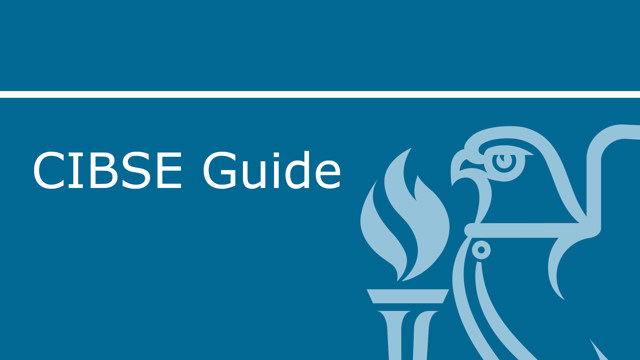
Guide A: Environmental design provides guidance on design criteria and calculation methods such as fabric performance, heating and ventilation system sizing, methods for thermal comfort evaluation and energy demand.
Note: This title references BS EN 779: 2012, which has been superseded by BS EN ISO 16890 Air filters for general ventilation. This Eurovent document provides a useful summary of the changes:
Note: Chapter 2 of Guide A supersedes TM34: Weather data with climate change scenarios (2004).
Files supplementing Guide A: Environmental design can be downloaded here:
Chapter 0: blank PAMDOC, PAMDOC example)
Chapter 2: solar radiation, long-wave radiation and daylight; world clear sky solar irradiance tables (by latitude); external design data (worldwide); Figure 2.8 Wind roses for the UK; Table 2.9 Frequency of dry/wet bulb temperatures (June–September); Table 2.12 Solar irradiation on inclined planes; Table 2.13 Solar irradiance on vertical and horizontal surfaces; Table 2.14 Sol-air temperatures; Table 2.19 Frequency of hourly wind speed by direction; Table 2.20 Frequency of hourly wind speed by temperature; Table 2.24 Predicted coincident dry and wet bulb temperatures (summer); Table 2.25 Predicted coincident dry and wet bulb temperatures (winter)
Chapter 5: appendices 7 through 12; Table 5.16 Cooling loads (unshaded) (UK); Table 5.17 Cooling loads (shaded) (UK); Table 5.18 Banded weather data; Table 5.X1 Cooling loads (unshaded) (worldwide); Table 5.X2 Cooling loads (shaded) (worldwide)
Full set of supplementary files (note - this is a large file, so may take some time to download).
Topics covered include:
- The design process
- Design calculations quality plan
- Sources of uncertainty
- User issues
- Performance assessment methods (pam)
- Environmental criteria for design
- Notation and definitions
- Thermal environment
- Modelling thermal comfort
- Environmental criteria
- Additional factors potentially affecting comfort
- Outdoor thermal comfort
- Determination of required outdoor air supply rate
- Visual environment
- Noise
- Vibration
- Determination of predicted mean vote (pmv)
- Measuring operative temperature
- External design data
- Notation
- UK near-extreme weather data
- UK cold weather data
- UK warm weather data
- Wet and dry bulb temperatures
- Worldwide weather data
- Solar and illuminance data
- Wind data
- Climate change
- Urban heat island effect
- Thermal properties of building structures
- Notation
- Heat losses from buildings
- Roofs
- Ground floors and basements
- Windows
- Thermal bypasses
- Linear thermal transmittance
- Non-steady-state thermal characteristics
- Moisture content of masonry materials
- Thermal conductivity and thermal transmittance testing
- Heat transfer at surfaces
- Seasonal heat losses through ground floors
- Application of the combined method to multiple layer structures
- Calculation method for admittance, decrement factor and surface factor
- Properties of materials
- Thermal properties of typical constructions
- Ventilation and air infiltration
- Ventilation and air quality
- Ventilating heat loss
- Ventilation systems
- Natural and mixed mode ventilation
- Methods for estimating air infiltration and natural ventilation
- Basic pressure coefficient data
- Summary of measured air leakage data
- Air infiltration development algorithm (aida)
- Thermal design, plant sizing and energy conservation
- Notation
- The role of standards
- Relationship to the design process
- Design calculation quality plan
- Thermal response
- Calculation methods for thermal design
- Heating plant sizing
- Cooling plant sizing
- Summertime temperatures in buildings
- Building energy demand
- Overview of calculation methods
- Equations for determination of sensible heating and cooling loads
- Calculation of operative and mean radiant temperatures
- Banded weather data
- Glass and glazing systems
- Example calculations
- Internal heat gains
- Benchmark values for internal heat gains
- Occupants
- Lighting
- Personal computers and office equipment
- Electric motors
- Cooking appliances
- Hospital and laboratory equipment
- Heat gain from laboratory animals
- Domestic appliances and equipment
- Rate of heat gain from restaurant/cooking equipment
- Moisture transfer and condensation
- Notation
- Psychrometry of water vapour in air
- Moisture content of materials
- Mechanisms of moisture movement
- Surface condensation and mould growth
- Interstitial condensation
- Inside and outside design conditions
- Condensation calculations
- Control of condensation
- Health issues
- Thermal discomfort and health implications
- Humidity
- Air quality and ventilation
- Visual environment
- Water quality
- Electromagnetic effects
- Noise and vibration
- Communities and health
Acknowledgements
Guide A Steering Committee: Derrick Braham (Derrick Braham Associates) (chair); Brian Anderson (BRE Scotland); David Arnold (Troup Bywaters + Anders); Geoff Levermore (University of Manchester); Martin Liddament (VEETECH Ltd.); Fergus Nicol (Oxford Brookes University); Marialena Nikolopoulou (University of Kent); Foroutan Parand (AECOM); Chris Sanders (Glasgow Caledonian University); David Williams (Parsons Brinckerhoff Ltd.); Runming Yao (University of Reading)
This 2015 edition of Guide A was reprinted in 2019; this hard copy version incorporates all corrections made after publication up to May 2019. One additional correction has been made on 12th January 2021, involving Equations 7.1 and 7.2 on page 7-3.
For purchasers of the hard copy version of Guide A, all of these corrections are detailed here: Guide A Corrigenda v16
The PDF version of Guide A available for download above incorporates all of these corrections. If you download the PDF above, it is not necessary to download the corrigenda.